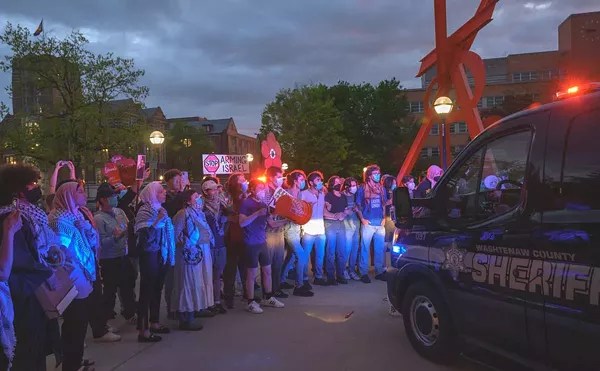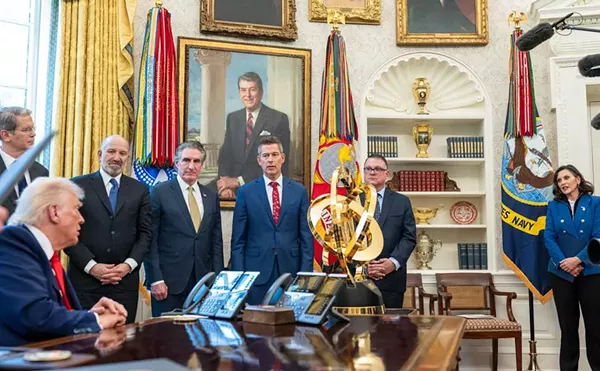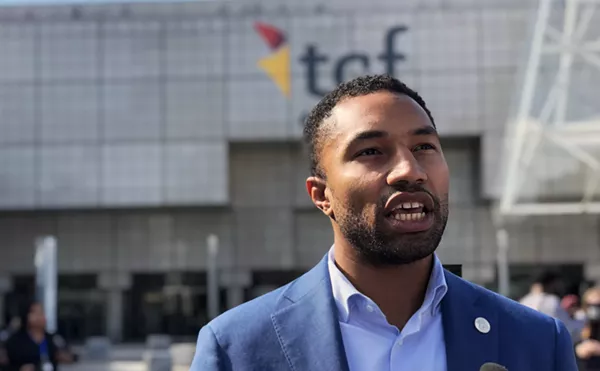
Audio By Carbonatix
[
{
"name": "GPT - Leaderboard - Inline - Content",
"component": "35519556",
"insertPoint": "5th",
"startingPoint": "3",
"requiredCountToDisplay": "3",
"maxInsertions": 100,
"adList": [
{
"adPreset": "LeaderboardInline"
}
]
}
]
Alice Gray, 28, began doing yoga about a year and a half before leaving home in Louisville, Ky., to attend medical school at the University of Michigan in Ann Arbor. It helps her relax and tune into her own health, she says.
Jessica Flynn, 32, began teaching herself about homeopathic medicine years before she decided to attend medical school at U-M. A native New Yorker, Flynn worked as a medical assistant at a family practice in Ann Arbor while she took premed courses. The doctors there routinely used acupuncture, nutritional medicine and holistic techniques in combination with more traditional treatments.
Yoga and homeopathy might seem at odds with a high-powered medical school such as the one at U-M. Western medicine and its education have traditionally been girded by the most rigorous principles of classical science. A treatment was deemed “effective” only if it could withstand meticulous, large-scale testing and demonstrate a clear physiological benefit. Factors such as mental health, environment and diet — not to mention the more spiritual aspects of the subject’s life — were routinely dismissed as insignificant or unmeasurable. The science of medical diagnosis was coolly analytical, dispassionately methodical and, above all, unabashedly reductionist. These ideas about medical science were rigidly instilled in student-doctors and reinforced throughout their careers.
But today’s medical students are of a different stripe. In addition to being more diverse in terms of race, gender and cultural background, they bring to medicine practices from their personal lives that are expanding how they approach their profession. While change may be slow in the staid institutions of medical education, many experts believe the doctor of the not-so-distant future will likely practice medicine in a markedly different way than the doctor of the not-so-distant past.
Informed choices
“The focus today is not on treatment but on healing,” says Rita Benn, Ph.D., director of the Integrative Medical Education Program at the U-M Complementary and Alternative Care Research Center. “You’re seeing a whole new paradigm of medical education emerge.”
Reformers such as Benn are talking about a small revolution in medical education. Their hope is to introduce complementary and alternative medicine (CAM) into medical school curricula. CAM typically includes a wide variety of treatments gathered from around the world and across the ages including acupuncture, herbs, massage therapy and t’ai chi, to name only a few. While patients and young doctors are receptive, many older doctors and the medical establishment — “organized medicine,” as it is called — is a bit slower to accept CAM into the fold.
“Patients want to know about these treatments, and doctors should be informed enough to help them make choices,” said Benn. “Some forms of CAM have shown remarkable results as treatment and some simply help patients cope with chronic pain or illness.”
Last year Consumer Reports magazine found that more than 120 million Americans sought some form of alternative treatment, up from about 80 million in 1990. While CAM care has traditionally been used for chronic conditions ranging from back pain to allergies to diabetes, it is now being studied and applied for life-threatening ailments such as cancer and heart disease. CAM advocates say that it is not only to medicine’s advantage to educate young doctors about these treatments, but given public interest and issues of safety, it is an obligation.
Currently Benn and others at the center help administer several CAM courses, some required and some electives, through the medical school. All 170 first-year medical students are required to take a seven-hour course in alternative medicine. About 85 of those will go on to take additional courses and even work with alternative practitioners over the following three years of school. The first-year course is built around a survey format that covers a variety of alternative treatments from herbal remedies to acupuncture to qigong (pronounced chee-gung), an ancient Chinese form of therapeutic touch, to herbal remedies.
“I didn’t know what therapeutic touch was going in, and it honestly seemed a bit hokey — what with the energy fields and chakras and all,” said Flynn, a second-year student, who worked with a qigong practitioner as part of her program. “But having a person touch you in a soothing manner will elicit a physical response from your body, such as lowering blood pressure.”
U-M is not alone among medical schools in its embrace of alternative medicine. According to a 1999 American Medical Association study, two-thirds of the nation’s 125 medical schools offer elective courses in complementary and alternative medicine ranging from stand-alone electives to clinical practice and even research. The most common topics taught are chiropractic, acupuncture, homeopathy, herbal therapies and a variety of mind-body techniques including yoga, therapeutic touch and meditation. Often the goal is not to train doctors in these healing arts, but to simply give them a better understanding and respect for what’s out there.
In their conclusion to the study, researchers noted that “medical education is under constant pressure to evolve” and that “physicians will increasingly be expected to responsibly advise patients who use, seek, or demand complementary and alternative care.” In response to the study the AMA now supports — though cautiously — CAM education for physicians.
Healing energies
“I think CAM treatments is not just about acupuncture or herbs or alternatives,” said Flynn. “One of the things that CAM curriculums do is help us to not lose sight of the complexities and the humanness of our patients, to see the whole patient and how they live.”
The qigong course, like many of the CAM courses offered at U-M, parallels research being done at the school. With grant money from several organizations, U-M researchers are looking to determine whether qigong therapy in the hospital setting may help speed the healing process and shorten the recovery period after surgery. The patient lies down fully clothed on a bed while a therapist places his or her hands in a sequential pattern moving from the patient’s head to toes. This removes “blocked energy,” possibly reducing pain levels and improving wound healing.
At dozens of other medical teaching and research institutions around the country the National Institutes of Health and other organizations are spending billions of dollars to validate the claims that practitioners of these treatments have been making — in some cases for centuries. Many of these studies are moving beyond merely examining the effectiveness of CAM at treating chronic pain and managing stress — areas where many alternative therapies are now widely acknowledged as effective — to examining their impact on the prevention and treatment of fatal illness such as cancer and heart disease.
Another U-M research project, this one sponsored by the American Academy of Family Physicians, is looking into CAM treatments of heart disease. While the rate of deaths related to heart disease has dropped dramatically in the last 30 years, it still kills more Americans than all other disease combined, reports the Centers for Disease Control. Because diet, exercise and stress are such huge factors in who gets heart disease, CAM therapies have excellent potential in prevention and treatment of the disease, said Benn.
“Most medicine, even traditional Western medicine, is about pain control or improving the body’s ability to heal itself,” said Benn. “Add to that the effectiveness of CAM therapies in the area of prevention and you’ve got a powerful resource for patients with heart disease.”
Cancer controversy
CAM treatments for cancer got a boost in the news last March when actress Suzanne Somers opted to use Iscador, a mistletoe extract, rather than chemotherapy to treat her breast cancer. Iscador, along with herbs to strengthen the immune system and massage to stimulate blood flow, is prescribed in Europe to 60 percent of cancer patients as a complement to traditional cancer treatment. Here in the United States, about one-third of cancer patients use some form of alternative therapy along with some form of Western medicine, reports the Journal of Alternative Therapies.
But Somers’ public profile and vocal advocacy for Iscador set off a firestorm of debate and harsh criticism from the medical community. Somers told CNN host Larry King in an April 24 interview that she “never expected this backlash, this stoning, from the Western medical establishment.”
The Food and Drug Administration estimates that 100 new so-called herbal remedies or alternative therapies become available each week to treat ailments from insomnia to impotency to AIDS. Most are ineffective and some are dangerous, especially if patients discontinued more conventional treatments or use herbs in combinations with prescription drugs without telling their doctor. The American Medical Association cautions patients and doctors alike against alternative therapies for which scant information is available.
“The truth is that there is often plenty of supportive research out there for a variety of CAM therapies, it’s just that doctors don’t know where to find it and how to interpret it in ways that are useful,” said Mary Ann Richardson, director of research for the National Center of Complementary and Alternative Medicine, part of the National Institutes of Health.
“The gold standard for medical testing is the large-scale, double-blind study that uses control groups, placebos and total anonymity to guarantee the accuracy of results. But alternative therapies depend on integration of every aspect of a patient’s life to be effective, rendering them difficult to test. And, most studies of alternative therapies are either foreign or of a smaller scale, making acceptance of the results by American doctors hard to secure,” said Richardson. The NIH is spending billions of dollars at teaching hospitals and research centers around the country to remedy this, she said.
“It’s a twofold issue,” said Richarson. “We need to build better long-term studies to please doctors and, at the same time, we need to teach doctors to look in new places for information and to accept what are, perhaps, much more complex webs of cause and effect.”
When Kenneth H. Musson graduated from U-M’s medical school in 1963, CAM as it is now known didn’t exist. Today Musson is an ophthalmologist in Traverse City and president of the Michigan State Medical Society, the statewide arm of the AMA. Musson is concerned that a fringe of medical education is moving away from its traditional scientific moorings.
“The University of Michigan has an excellent medical school,” said Musson. “But we came from shamans and medicine men and I’d hate to see us return to that,”
Musson readily acknowledges the effectiveness of meditation and even acupuncture for some patients, but treatments without a solid foundation in science have no place in medicine, he said.
Musson also pointed out that much of what is today called CAM has been practiced by doctors under other names for years. Chief among them is the ability to hear what a patient has to say. Musson’s grandfather graduated from U-M’s medical school in 1900. Musson reverently describes his grandfather’s eloquent medical notes and his insight into diseases they did not yet understand.
“He had a sensitivity to his patients and an ability to listen,” He said. “The talk today is about spending time with patients and treating the whole patient. Good doctors have been doing that for years.”
Benn acklowdeges that a lot of what is old, in fact,is new again. It is the understanding of how many CAM therapies work and their growing acceptance in the halls of medical education that is changing. And most importantly, she said, it is people’s comprehension of health and their expectations of medicine that isbeginning to change.
"Most people — doctors, too — are accepting of CAM once they begin to understand it,” she said.
"Fundementally it is about drawing the widest variety of resources — including the patient — into the healing process. Who can argue with that?"
John Smock is an occasional contributor to the Metro Times. E-mail letters@metrotimes.com




